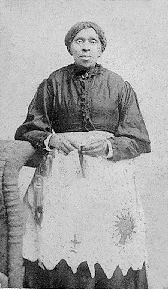

Queer Places:
Gospel Pilgrim Cemetery, 164A3, A012, Athens, GA 30601
 Harriet
Powers (October 29, 1837 – January 1, 1910) was an African-American slave,
folk artist, and quilt maker from rural Georgia. She used traditional
appliqué techniques to record local legends, Bible stories, and
astronomical events on her quilts. Only two of her quilts are known to
have survived: Bible Quilt 1886 and Pictorial Quilt 1898.
Her quilts are considered among the finest examples of nineteenth-century
Southern quilting.[1]
Her work is on display at the National Museum of American History in
Washington, DC, and the Museum of Fine Arts in Boston, Massachusetts.
Harriet
Powers (October 29, 1837 – January 1, 1910) was an African-American slave,
folk artist, and quilt maker from rural Georgia. She used traditional
appliqué techniques to record local legends, Bible stories, and
astronomical events on her quilts. Only two of her quilts are known to
have survived: Bible Quilt 1886 and Pictorial Quilt 1898.
Her quilts are considered among the finest examples of nineteenth-century
Southern quilting.[1]
Her work is on display at the National Museum of American History in
Washington, DC, and the Museum of Fine Arts in Boston, Massachusetts.
Powers was born into slavery near Athens, Georgia. Historians say she spent her early life on a plantation owned by John and Nancy Lester in Madison County, Georgia, where it is believed she learned to sew from other slaves or from her mistress.[2]
Though an 1895 Chicago Tribune article[3] about the Cotton States and International Expo characterizes Powers as ignorant and illiterate, only learning Bible stories from "others more fortunate", quilt historian Kyra E. Hicks discovered during research for her book This I Accomplish: Harriet Powers' Bible Quilt and Other Pieces[4] a letter written by Powers explaining how she came to be literate and that she learned bible stories, which served as the inspiration for her quilt work storytelling through her own study of the bible.
In 1855, at the age of eighteen, Powers married Armstead Powers.[5] They had at least nine children.[6] Harriet's husband, Armstead Powers identified himself as a 'farmhand' in the 1870 census; Harriet is listed as 'keeping house', and three children , Amanda, Leon Joe (Alonzo) and Nancy lived at home.[7] In the 1880s, after being freed at the end of the Civil War, they owned four acres of land and had a small farm.[8] During the 1890s, due to financial difficulty, her husband slowly sold off parcels of their land, defaulted on taxes, and eventually left Harriet and their farm in 1895. Powers never remarried and probably supported herself as a seamstress.[9] For most of her life she lived in Clarke County, mainly in Sandy Creek and Buck Branch.
In 1886, Powers began exhibiting her quilts. Her first quilt, known as the Bible Quilt, was shown at the Athens cotton Fair in 1886;[6] it is this quilt that is now in the Smithsonian Institution. Jennie Smith, an artist and art teacher from the Lucy Cobb Institute, saw the quilt, which she found to be remarkable,[10] at the fair and asked to purchase it, but Powers refused to sell. The two women remained in touch, however, and when Powers met with financial difficulties four years later, she agreed to sell the piece for five dollars. At the same time Powers vividly explained the imagery on the quilt; Smith recorded these explanations, adding notes of her own in her personal diary.[2] She communicated with her narrative quilts using themes from her own experience and techniques from the age-old crafts of African Americans.
TThe history of the second quilt is unclear. One account suggests that it was commissioned by the wives of faculty members of Atlanta University, who had seen the first quilt at the Cotton States Exhibition in Atlanta in 1895. According to another source, the quilt was purchased in Nashville, Tennessee, in 1898. Whatever its origins, the piece was presented to the Reverend Charles Cuthbert Hall of New York City, who was serving as the vice-chairman of the university's board of trustees at the time. The reverend's heirs sold the quilt to collector Maxim Karolik, who then donated it to the Museum of Fine Arts, Boston.
Powers died on January 1, 1910, and was buried in the Gospel Pilgrim Cemetery in Athens. Her grave was rediscovered in January 2005.[11]
My published books: